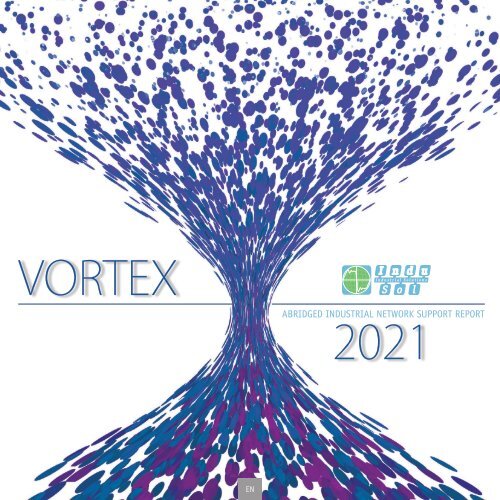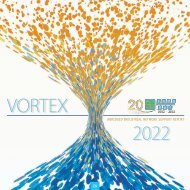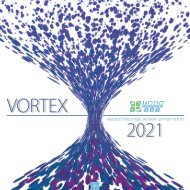VORTEX Report 2021 englisch
What is the condition of our industrial networks? The VORTEX Report delivers answers: It packs the learnings from Indu-Sol's measuring activities over an entire year across all borders of technologies and countries into a single document. Have a look now!
What is the condition of our industrial networks? The VORTEX Report delivers answers: It packs the learnings from Indu-Sol's measuring activities over an entire year across all borders of technologies and countries into a single document. Have a look now!
Create successful ePaper yourself
Turn your PDF publications into a flip-book with our unique Google optimized e-Paper software.
<strong>VORTEX</strong><br />
ABRIDGED INDUSTRIAL NETWORK SUPPORT REPORT<br />
<strong>2021</strong><br />
EN
PREFACE<br />
Availability – Is It a Matter of Course, a Feat, or an Ongoing Process?<br />
Dear Customers,<br />
Dear Business Partners,<br />
Dear Potential Customers,<br />
Have you ever observed our teenagers today when “the Wi-Fi is<br />
down” all of a sudden? We have been able to watch a panicked reaction<br />
quite similar to that one around the toilet paper shelves when<br />
it became apparent that some stores would have to close for a while.<br />
An item that costs no more than a few cents and seemed to be incapable<br />
of running out in the store or on the loo suddenly turned into<br />
a precious commodity – never mind its status as “essential goods”.<br />
These changes were also evident for paper-roll manufacturers as permanent<br />
full utilisation of their production capacities was required<br />
virtually over night. The demand might even have justified production<br />
capacity increases in many a company. About three weeks after<br />
the first lockdown commenced in the spring of 2020, Indu-Sol received<br />
its first emergency call from a toilet paper manufacturer. Its<br />
plant had stopped. The automation system needed to be repaired in<br />
a feat of strength.<br />
This exemplary incident suddenly highlighted the essential position<br />
of yet another element doomed to exist in the shadows under normal<br />
circumstances: the network. While machines and plants are running<br />
and production is not utilised to capacity, no one tends to care<br />
about it. It's just assumed to be available. Isolated network-related<br />
incidents are acknowledged, and minor interruptions are tolerated.<br />
An availability of 80% seems sufficient and acceptable. The toilet<br />
paper example shows, however, how quickly the tide can turn, and<br />
why network availability should be scraping 100% as closely as possible<br />
by default. Anyone who has ever contracted a stomach bug<br />
(which tends to happen quite suddenly and unexpectedly) will remember<br />
their gratitude when they had more than a single roll with<br />
three sheets remaining on it at home...<br />
We have prepared some other lessons learned from the year of 2020 in<br />
metrological terms on the following pages.<br />
With kind regards, and wishing you enough toilet paper on the roll<br />
at all times, I remain<br />
Yours, René Heidl,<br />
Managing director for technology & support<br />
Indu-Sol GmbH<br />
2
BUFFERS ARE KEY!<br />
Network and Toilet Paper – Virtually Unnoticed and Yet Essential<br />
When production utilisation needs to be ramped up quickly and stay at 100% of capacity permanently, strain on the network becomes evident<br />
as well. Anyone entering this extreme situation with an 80% availability buffer or less does so accepting needless competitive disadvantages.<br />
However, while the spare stocks are easily evident in the case of the toilet paper roll, networks require visualisation by way of a monitoring<br />
system. Let us show you a slightly frivolous comparison below.<br />
100% reserve – you're ready to face any<br />
situation!<br />
Your reserve feels alright, but if the demand<br />
were to increase suddenly (market<br />
change or stomach bug), it would<br />
quickly reach its limit.<br />
The sudden demand increase cannot be<br />
served since there are not enough spare<br />
units in stock, leading to a loss of comfort<br />
or turnover that could have been avoided.<br />
3
HELP FROM AFAR<br />
The Rise of Remote Diagnosis – Reaching the Network through the Virtual Tunnel<br />
What to do if troubleshooting or (regular) inspection measurements<br />
in the network are due, but no measuring engineer is available right<br />
then? For several years, companies have been technically able to<br />
give an external service engineer secure access to diagnostic data (if<br />
available) by way of a VPN tunnel (VPN = Virtual Private Network).<br />
However, this option was virtually never used in the past. It was<br />
subject to great security concerns and it seemed too convenient to<br />
have the service engineer physically travel to site even if it required<br />
more time and was subject to needlessly high costs.<br />
The security situation has not changed at all, but the pandemic<br />
has brought travel and access restrictions for external companies in<br />
2020, inevitably changing the perception of remote access to internal<br />
networks by external partners within companies. Safety-relevant<br />
incidents have not become known yet. Every single time, however,<br />
the customer could be helped comparatively quickly.<br />
If current and historical diagnostic data were available from a monitoring<br />
system already installed on site as well, many deployments<br />
could be completed remotely, increasing efficiency for the customer<br />
and the service provider alike. These observations suggest that remote<br />
access will be granted to external partners more frequently or<br />
more extensively in the future than it was before. For an interesting<br />
example from practice, see pages 10/11.<br />
4
CHART<br />
Distribution of Deployment Types<br />
Indu-Sol measuring engineers were deployed to verify communication quality in the fieldbus or network on the customer's behalf a total of<br />
421 times in 2020.<br />
Troubleshooting – 167 deployments<br />
Reactive detection of at least one weakness in the<br />
fieldbus/network that led to functionally relevant<br />
irregularities.<br />
Delivery concept measurement – 39 deployments<br />
Contractually agreed inspection measurement at commencement<br />
or within the course of the network's life<br />
cyclezyklusses<br />
Consulting – 6 deployments<br />
Plant inspections and test measurements<br />
for technical requirements<br />
analysis.<br />
6<br />
167<br />
39<br />
144<br />
65<br />
Phone support– 65 deployments<br />
Travel restrictions and greater obstacles to access of third parties<br />
to companies have led to a steep rise of metrological “remote diagnoses”.<br />
However, help is rarely possible or requires great effort<br />
(e.g. by sending out loaned equipment) if no data are available<br />
from monitoring devices already installed on site.<br />
Measurement – 144 deployments<br />
Checking if specifications are met and stable<br />
communication is achieved.<br />
5
DEPLOYMENT DISTRIBUTION<br />
Measuring Methods Determine Remote Feasibility: The PROFINET Advantage<br />
As already explained on pages 4 and 5, the pandemic rendered onsite<br />
measurements much less possible in 2020 than they used to<br />
be in the years before. This led to a lower number of PROFIBUS<br />
and EMC measuring deployments than in “regular years”. EMC, for<br />
example, has become insignificant in frequency in the table on page<br />
7. PROFIBUS hardly permits precise diagnosis of the reasons for impaired<br />
data communication using nothing but logic analysis that is<br />
possible via remote access. Since all participants communicate on<br />
the same line, it is difficult to tell where the damaged telegram that<br />
reaches the master broke on its way. Issues for EMC analysis are even<br />
greater: Analogue measuring devices on site are vital for measuring<br />
impedances and shield currents on individual line sections. At least,<br />
there are some current meters that can measure shield currents on<br />
different sources in parallel.<br />
Experience in PROFINET networks, on the other hand, has shown that<br />
poor data transmission quality usually has some logical causes. As a<br />
result, it can be determined quite well by reading out the diagnostic<br />
data from switches (provided that managed switches are installed)<br />
or a corresponding monitoring system. EMC analysis and even line<br />
diagnostics can be performed with a simple click, using switches<br />
with the corresponding function and avoiding any additional meters<br />
with their associated effort by now.<br />
6
CHART<br />
Reasons for Customers Placing Measuring Orders with Indu-Sol<br />
Industrial<br />
Ethernet<br />
Other<br />
2015 2016 2017 2018<br />
2019 2020<br />
28% 32 % 36 % 38 % 37 % 55 %<br />
55 % 49 % 45 % 43 % 43 % 30 %<br />
5 % 5 % 5 % 3 % 3 % 7 %<br />
Industrial<br />
Ethernet<br />
Other<br />
0,07 % 0,2 % 0,3 % 4 % 5 % 3 %<br />
5 % 4 % 3 % 4 % 6 % 5 %<br />
7
ERROR CAUSES<br />
Clear Communication: The Network as the Tower of Babel<br />
Some inexplicable gaps in the historical record mean that we will<br />
never learn whether industrial networks were already known in ancient<br />
Babylon or not. However, the biblical legend of the Tower of<br />
Babel symbolises the relevance of flawless communication for a complex<br />
project's success. Even the smallest flaw in the exchange of<br />
information may create a domino effect that causes everything to<br />
collapse. Measurement deployments reveal such intricacies in industrial<br />
networks.<br />
The proportion of vulnerabilities found in the logical area can be<br />
expected to show the highest figures due to the increase in remote<br />
diagnostics as explained on the previous pages. This is compounded<br />
because existing networks keep “ageing”. Their devices lose functional<br />
efficiency due to their long operating times, and due to incompatibilities<br />
caused by multiple software and firmware versions.<br />
The latter reason was and remains needlessly frequent. Line issues,<br />
the second-most frequent cause in the past year, show that dispensing<br />
with line tests comes at a risk. Let us also mention that<br />
although EMC was initially suspected as the cause in a considerable<br />
share of the deployments, it was only identified as such in one fifth<br />
of all cases.<br />
Poorly assembled or defective connectors must be kept in mind as<br />
an avoidable cause of communication errors, just as compliance with<br />
assembly and installation guidelines, e.g. concerning cable lengths.<br />
8
CHART<br />
Typical Error Sources in Measuring Deployments<br />
Cable lengths<br />
exceeded<br />
Miscellaneous<br />
EMC<br />
Cables<br />
Software & equipment<br />
Plugs<br />
2015 2016 2017 2018 2019 2020<br />
Software & equipment 21 % 20 % 16 % 4 % 13 % 28%<br />
Cables 15 % 14 % 31 % 28 % 18 % 21%<br />
EMC 36 % 24 % 23 % 20 % 15 % 20%<br />
Plugs 11 % 18 % 20 % 30 % 18 % 14%<br />
Cable lengths exceeded 4 % 9 % 4 % 10 % 4 % 6%<br />
Miscellaneous 13 % 15 % 6 % 8 % 32 % 11%<br />
9
OUTLOOK<br />
Case Study: Homogeneous, Separate Machine Networks are Disappearing<br />
Physically separate networks are still frequently installed today, even<br />
in PROFINET- or Ethernet-based systems, for reasons of safety and<br />
avoidance of issues with double addressing. However, the example of<br />
a mechanical-engineering company that contacted us reflects their<br />
limited capacities in practice: The manufacturer of the frequency<br />
inverters installed in each machine network (see figure at the top of<br />
p. 11) needed remote access to the devices for reading the operating<br />
status and setting parameters. In the above starting position, this<br />
required four access points, i.e. one per device, due to the physically<br />
separated networks. The networks were first physically connected<br />
to each other and logically separated by means of VLAN. This did<br />
nothing to resolve the issue of needing four remote maintenance<br />
access points. Eventually (see figure at the bottom of p. 11), a VLAN<br />
router had to be installed. At least the current solution lives up to<br />
the highest demands to availability and security alike.<br />
Nevertheless, this shows that physical separation of networks is becoming<br />
less and less appropriate. Logical separation combined with<br />
conscientious planning enables a justifiable “opening” of the internal<br />
system architecture to the outside. However, since this example<br />
was lacking in the planning stage, great effort was required in dayto-day<br />
operation and personnel resources had to be brought in from<br />
other points. The corresponding simulation software can help avoid<br />
such expensive subsequent retrofits from the beginning. Find a planning<br />
example here: www.indu-sol.com/en/pnp2-vlan.<br />
10
PRACTICE TOPOLOGY<br />
Secure Remote Access and Stable Operation: Logical Separation via VLAN<br />
Can be accessed from the internet, pluggable<br />
Starting point<br />
Server<br />
SWITCH<br />
Customer service overview<br />
SPS 1 SPS 2 SPS 3 SPS 4<br />
Remote<br />
maintenance<br />
PN network machine 1<br />
incl. frequency converter<br />
PN network machine 2<br />
incl. frequency converter<br />
PN network machine 3<br />
incl. frequency converter<br />
PN network machine 4<br />
incl. frequency converter<br />
Can be accessed from the internet, pluggable<br />
Elaborately retrofitted solution<br />
Server<br />
SWITCH<br />
Customer service overview<br />
SPS 1 SPS 2 SPS 3 SPS 4<br />
VLAN 5<br />
VLAN<br />
Router<br />
Remote<br />
maintenance<br />
VLAN 5<br />
VLAN 1<br />
PN network machine 1<br />
incl. frequency converter<br />
VLAN 2<br />
PN network machine 2<br />
incl. frequency converter<br />
VLAN 3<br />
PN network machine 3<br />
incl. frequency converter<br />
VLAN 4<br />
PN network machine 4<br />
incl. frequency converter<br />
Initially not desired, but eventually added in an expensive retrofit that is at least secure and highly available: four homogeneous, physically<br />
separated PROFINET networks (top) were turned into a single heterogeneous network logically separated by a VLAN router (bottom).<br />
11
Indu-Sol GmbH<br />
Blumenstrasse 3<br />
04626 Schmoelln<br />
Phone: +49 (0) 34491 580-0<br />
Telefax: +49 (0) 34491 580-499<br />
info@indu-sol.com<br />
www.indu-sol.com<br />
Certified to DIN EN ISO 9001:2015<br />
Learn more about Indu-Sol:<br />
As of 03/<strong>2021</strong>

















